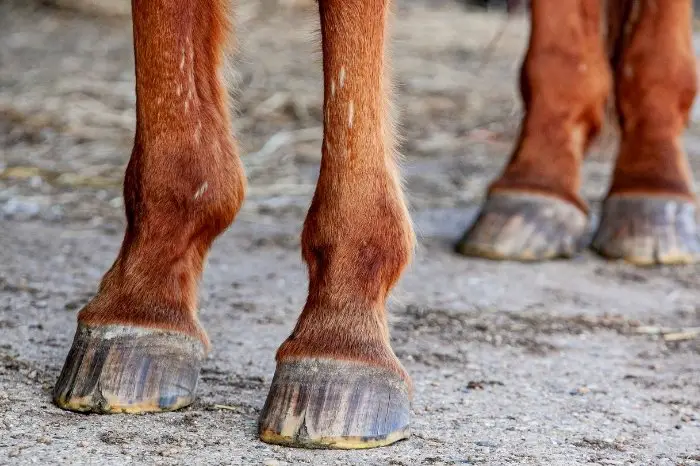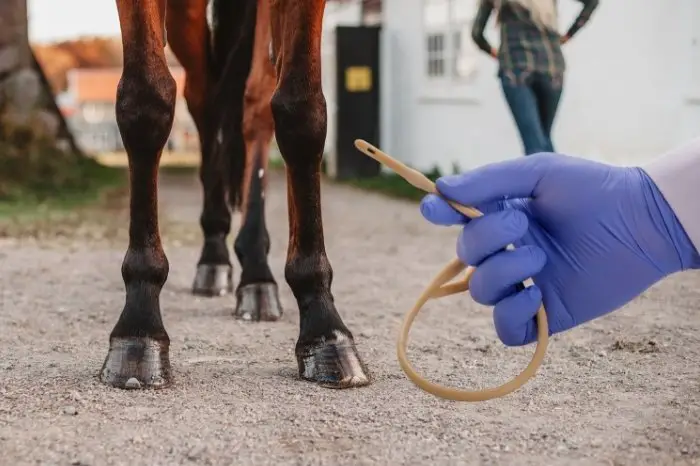Last Updated on July 24, 2022
Cellulitis is a fairly common condition that most often affects the legs of horses. So, just what is cellulitis in horse legs? This frustrating condition can affect many different horses and it can come on quickly.
If you expect your horse has cellulitis, you should contact your veterinarian so your horse can get proper treatment. Your veterinarian can provide proper treatment for your horse that has cellulitis. Once horses get cellulitis, they can be somewhat prone to developing it again.
What Is Cellulitis In Horse Legs?
Cellulitis is a bacterial infection that affects the soft connective tissues under the skin. Though it can occur anywhere on the body, it is most likely to happen on the legs.
Cellulitis can occur any time of year but is most likely to happen during the wet season. It can affect horses of all ages, breeds, and activity levels. There are two types of cellulitis: primary and secondary.
Primary
Primary cellulitis happens in cases with no root cause. It is most common in Thoroughbreds but can happen to horses of any breed.
Secondary – Cellulitis In Horse Legs
Secondary cellulitis occurs in horses when there is a known cause. Only about 50% of cases have a known cause and they can affect any breed of horse.
Check Out What Is Respiration On A Horse?
What Causes Cellulitis In Horses?
In many cases, the cause of cellulitis is unknown. It can occur after surgery, joint injections, wounds or trauma. In other cases, dew poisoning, mud rash, scratches, and cracked heels can lead to the development of cellulitis.
Generally, the bacteria involved include Staphylococcus and Streptococcus species, though other types can cause it to occur. The bacteria generally get into a horse through a cut or an abrasion, a surgical incision, a hock injection, severe chapping, or scratches. However, in some cases, the damage is caused by blunt trauma whether than a break in the skin.
Symptoms Of Cellulitis In Horses
Cellulitis is most commonly categorized by extreme swelling in the leg. It is often sudden and causes what is known as a ‘stovepipe’ leg, which is characterized by extensive swelling and loss of normal contours.
Cellulitis of the leg generally begins around the lower leg, around the heels, pastern, or fetlock. The swollen area is often hot to the touch and painful for the horse. It is often associated with lameness and in serious cases, horses may avoid putting weight on the leg.

Oftentimes, a horse will develop a fever as well. Since it is a painful condition, some horses may go off their food.
Diagnosing Cellulitis In Horses
If your horse is exhibiting the signs of cellulitis, you should contact your veterinarian. Cellulitis displays similar symptoms to lymphangitis, so your veterinarian will be able to give your horse a proper diagnosis.
It is important for a veterinarian to rule out other causes of the lameness and swelling in order to provide proper treatment. Your veterinarian may perform a physical, ultrasound, or bloodwork.
Treatment For Cellulitis
Upon diagnosis, your veterinarian will come up with a treatment plan for taking care of cellulitis. In most cases, drugs will be administered along with cold therapy and bandaging.
Antimicrobial Drugs
Antimicrobial drugs may be administered to horses with cellulitis. In some cases, a veterinarian may inject suitable diluted antimicrobial into a vein with a tourniquet.
Anti-inflammatory Drugs
Systemic nonsteroidal anti-inflammatory drugs including flunixin meglumine or phenylbutazone may be administered to your horse. These drugs help reduce swelling and can help with discomfort. If needed a veterinarian may also recommend a topical anti-inflammatory to be applied to the affected area.
Bute-Less Comfort & Recovery Supplement Pellets, Healthy Inflammatory Response, 5 lb
Cold Therapy
Cold therapy can be very beneficial to horses with cellulitis. Cold can help reduce swelling while also slowing down bacterial growth.
Ice boots or ice packs are the best way to apply cold therapy to your horse. The leg may be iced for 20 to 30 minutes at a time every hour or on a schedule created by a veterinarian. Ice should be changed frequently to ensure it stays cold enough to work effectively as a treatment.
Bandaging – Cellulitis In Horse Legs
Supportive wraps can be beneficial as they can limit swelling. However, they should be used with care as they can trap in heat. Wrapping can be combined with icing as an effective way to treat cellulitis.
Movement
Movement stimulates circulation in the leg, which can help speed up the healing process. When the pain reduces, put your horse in a large stall or small paddock where there is space to move around without overdoing it. Hand walking in five to 10-minute sessions every day can also be helpful as well.
Surgical Drainage
In severe cases, surgical drainage may be used to treat cellulitis. Surgically draining pockets of infection can help resolve problematic cases. Advanced ultrasound imaging is used as a guide and the horse is often put under general anesthesia or sedated.

Dealing With Cellulitis In Horses
Cellulitis is a bacterial infection that affects the soft connective tissues under the skin, most commonly affecting a horse’s legs. It is a relatively common infection and in most cases the cause is unknown.
Do you have any questions regarding cellulitis in horse legs? If so, please ask any questions regarding cellulitis in horses in the comments.
FAQ’s
Can a Horse Recover from Cellulitis?
A horse can fully recover from cellulitis within days. However, in serious cases, some horses may experience damage from the infection. Some horses may also get reoccurring bouts of cellulitis.
What Causes Cellulitis in Horse's Legs?
In most cases, the exact cause of cellulitis is unknown. However, it can happen from urgery, joint injections, wounds, trauma, dew poisoning, mud rash, scratches and cracked heels.
How Serious is Cellulitis in Horses?
If your horse has symptoms of cellulitis, you should contact your veterinarian as some cases can become serious. However, in most cases, a horse will be able to make a full recovery with the right care within a few days.
Is Cellulitis Common in Horses?
Cellulitis can be a common occurrence in horses. It can happen to horses of all ages, activity levels and breeds, though most cases occur in the wet season.
